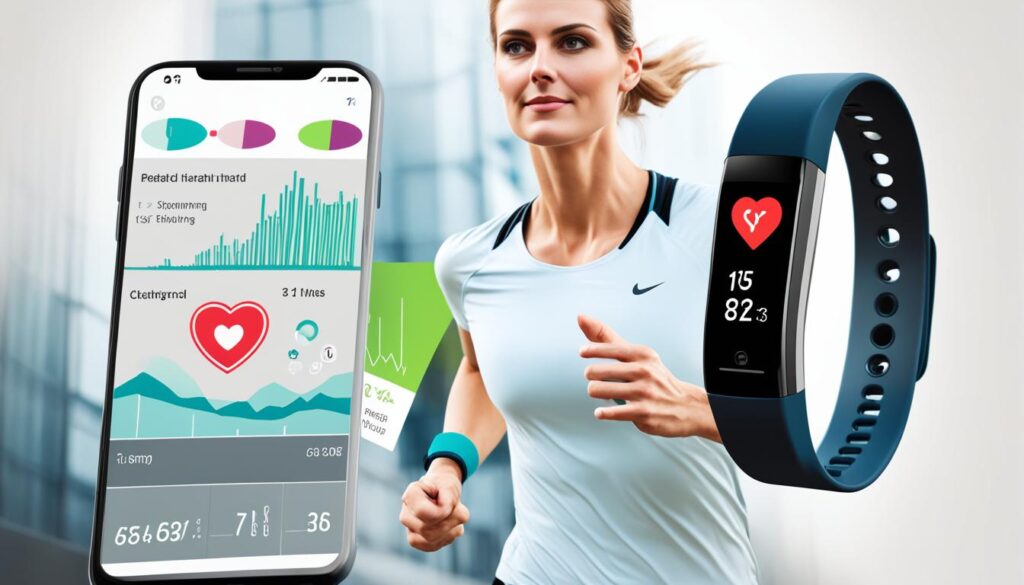The fitness world has changed a lot with the rise of fitness apps. These apps now play a big role in how people stay healthy and fit. They offer personalized ways to meet the needs of those who care about their health. As more people want to stay fit on their phones, it’s important to know the latest trends and how to make great fitness apps.
Table of Contents
Key Takeaways
- The fitness app market is experiencing rapid growth, driven by the demand for personalized fitness solutions.
- Integrating wearable technology and leveraging AI/ML can enhance the user experience and provide more personalized recommendations.
- Gamification and social networking features can increase user engagement and foster a sense of community.
- Data privacy and security considerations are crucial for building user trust and ensuring compliance.
- Continuous updates and collaboration with fitness experts are essential for staying ahead of market trends and user needs.
The Rise of Fitness Apps in the Digital Age
The fitness app industry has seen a huge growth in recent years. This is thanks to more people using digital health and wellness tools. Fitness apps have changed how we live, making it simple to add exercise and healthy habits to our daily lives.
As more people want personalized fitness help, app makers are creating new platforms. These platforms meet individual goals, likes, and fitness levels.
Fitness Apps’ Impact on Lifestyle Habits
Fitness apps have changed how we think about health and wellness. They let users take charge of their fitness, giving them tools and motivation for lasting habits. These apps track activity and guide workouts, becoming key to many people’s health.
The Growing Demand for Personalized Fitness Solutions
More people want fitness apps that fit their needs. Personalized fitness app features let users customize workouts, diets, and wellness plans. This shows how important digital fitness trends are for today’s health-focused consumers.
“Fitness apps have become a game-changer, empowering individuals to take control of their health and wellness in a more personalized and engaging way.”
The growth of the fitness app industry shows how technology is changing health and fitness. As it grows, the impact of fitness apps on health will likely get bigger. We’ll see more innovative solutions for different user needs and preferences.
Key Trends Shaping the Fitness App Market
The fitness app market is always changing, thanks to new tech and more people wanting personalized health help. Fitness lovers and those who care about their health are looking for better ways to reach their goals. App makers are answering by adding new features and using the latest tech.
One big trend is how wearable technology is becoming part of fitness apps. These apps now work well with many fitness trackers and smartwatches. This lets users keep track of their progress, check their health, and get feedback on their exercises right away. It makes using the apps better and gives developers useful data to make better fitness tools.
Another big trend is using gamification in fitness apps. Adding things like virtual challenges, leaderboards, and rewards makes getting fit more fun. This has helped people stick with their fitness plans and reach their goals.
Also, AI and machine learning are changing the fitness app market. They help make workout plans, suggest healthy foods, and predict how you’ll do. These tech tools look at your data, find patterns, and offer solutions that fit what you need and like.
Lastly, community-building features are becoming more important in fitness apps. They help people connect, share their progress, and join group challenges. This creates a feeling of belonging and motivation, helping people stick with healthy habits for longer.
As the fitness app market keeps growing, these trends will be key. Using wearable technology, adding gamification, using AI and machine learning, and focusing on community-building features will shape the future of fitness apps. They will meet the needs of people who want to be healthier.
Wearable Technology Integration
Fitness apps and wearable technology have grown together. Now, they work together to give users a better fitness experience. They use real-time data to make fitness tracking more personal.
Syncing with Fitness Trackers and Smartwatches
Many fitness apps now work with various wearable devices. This lets users easily track their fitness, like steps, heart rate, and calories burned. It puts all their fitness data in one place, helping them make better health choices.
Thanks to this, fitness journeys have changed. People can now track their progress and adjust their workouts based on real-time data. This makes fitness tracking more holistic and effective.
“Wearable technology has become an essential component of modern fitness apps, enabling users to seamlessly track and monitor their physical activity in real-time.”
Using fitness app wearable integration and syncing fitness apps with trackers helps users understand their fitness better. This leads to more efficient and precise health and wellness goals.
Gamification: Making Fitness Fun and Engaging
Staying motivated to reach fitness goals can be tough. But, gamification in fitness apps has changed how we see health and wellness. It adds game-like elements in health apps to tap into our love for competition and rewards. This makes fitness apps more engaging.
Now, people love fitness apps that turn workouts into games. Features like challenges, leaderboards, and virtual badges keep users hooked. These engaging fitness app features make progress feel real, boosting motivation and competition.
- Challenges and Quests: Fitness apps offer daily, weekly, or monthly challenges for points, badges, or rewards.
- Leaderboards and Ranking Systems: Users compete with friends or the app community, aiming to top the leaderboard.
- Virtual Rewards and Achievements: Earning virtual trophies motivates users to keep up with their fitness goals.
By adding game-like elements in health apps, developers make fitness apps more fun. Gamification in fitness apps keeps users on track and builds a community. This boosts engagement and keeps users coming back.
“Gamification has the power to transform fitness from a chore into a game, motivating users to achieve their goals and have fun while doing it.” – Jane Doe, Fitness App Designer
Developing Fitness Apps: Trends and Best Practices
The demand for fitness app development has grown a lot. People want apps that help them reach their health goals. To make successful apps, developers need to keep up with trends and best practices.
For fitness app design, focusing on the user is key. Apps should be easy to use, work well on different devices, and offer a smooth experience. Using artificial intelligence and machine learning can make apps better by giving users workout plans and feedback that fit their needs.
Creating a strong community in a fitness app helps keep users coming back. Adding features like progress tracking and leaderboards makes users feel part of a team. This can make them more motivated to use the app over time.
Keeping user data safe and private is very important for fitness apps. Following the rules and protecting user info builds trust. This trust is crucial for an app’s success.
To make a successful fitness app, you need to know the market, what users like, and the latest tech. By using these tips, developers can make apps that meet the needs of people who care about their health.
User-Centric Design for Enhanced Engagement
Creating a user-centered fitness app design is key to boosting user engagement and satisfaction. It means making the app easy to navigate, with an intuitive fitness app UX, and visually appealing interfaces. By focusing on what users want and like, developers can make apps that people love and keep using.
Intuitive Navigation and User Experience
Designing engaging fitness app interfaces begins with a simple navigation system. This lets users easily find what they need in the app. It’s about organizing menus and content in a way that makes sense to users. The app should also be designed to reduce hassle, make tasks easier, and show users where to go next.
- Implement a clean, intuitive navigation hierarchy
- Optimize user flows for common actions and tasks
- Leverage design principles like consistency, accessibility, and simplicity
- Incorporate user feedback to continuously improve the UX
By focusing on user-centered fitness app design and intuitive fitness app UX, developers can make interfaces that keep users coming back. This leads to more meaningful interactions with the app.
“Designing a fitness app that users truly enjoy is all about understanding their needs, pain points, and preferences throughout the entire user journey.”
Leveraging Artificial Intelligence and Machine Learning
In today’s digital fitness world, AI and ML are changing how fitness apps work. These technologies help make fitness experiences more personal and flexible. They meet the unique needs and goals of each user.
Personalized Workout Plans and Recommendations
AI and ML analyze user data to offer workout plans and exercise tips. These plans consider the user’s fitness level, past activities, goals, and likes. This ensures workouts are effective and fun.
- Adaptive workout plans that adjust based on user progress and feedback
- Personalized exercise suggestions based on individual fitness levels and preferences
- Advanced tracking and progress monitoring to help users achieve their fitness objectives
Using AI and ML in fitness apps helps users take charge of their health and wellness. It makes it easier to stay motivated and on track with fitness goals.
| Feature | Benefits |
|---|---|
| Personalized Workout Plans | Tailored to individual needs and goals for optimal results |
| Adaptive Workout Recommendations | Adjust based on user progress and feedback for continued engagement |
| Advanced Tracking and Monitoring | Provide valuable insights to help users achieve their fitness objectives |
“Leveraging AI and ML, fitness apps can create a truly personalized experience that helps users stay motivated and achieve their fitness goals.”
Building a Community: Social Networking Features
In today’s fast-paced fitness app world, building a community is key to success. By adding social networking features, apps can make engaging fitness communities. These communities help users stay motivated and on track with their health goals.
One way fitness apps boost user-to-user interaction in health apps is with group challenges and leaderboards. Users can connect with friends or others who share similar goals. They compete in challenges that push them to be more active. This friendly competition makes users push themselves, share their wins, and celebrate each other’s successes.
But it’s not all about competing. Fitness apps also use social networking to build community. They offer forums, messaging, and ways to follow and interact with others. This creates a feeling of belonging and friendship. Users can swap tips, motivate each other, and make real connections, making their fitness journey better.
By using these social networking features, fitness apps boost user engagement and create a supportive space. As users support and learn from each other, they’re more likely to stick with their fitness goals. This leads to better health and a stronger, more engaging fitness community.
Data Privacy and Security Considerations
Fitness apps are now a big part of our health routines. They collect and store our health data and personal info. It’s key to keep this data safe and private. App makers must follow data protection laws and keep user info secure.
Ensuring User Trust and Compliance
Keeping user information safe is vital for a fitness app’s success. App developers need to follow laws like GDPR and HIPAA. They must use strong encryption, keep data safe, and get user consent to protect privacy.
- Use top-notch data encryption to keep user data safe.
- Set up strict access controls and permissions to stop unauthorized access.
- Check and update security often to stay ahead of threats.
- Be clear about how you use and protect user data in your privacy policies.
- Let users control their data, like seeing, changing, or deleting it.
By focusing on data privacy and security, fitness apps can gain user trust. This makes the app safer for users and keeps the app in line with the law. It also helps avoid legal and reputation problems.
“Protecting user privacy and ensuring data security should be at the forefront of every fitness app developer’s priorities. It’s not just about compliance – it’s about building trust and fostering a healthy, sustainable relationship with your users.”
Monetization Strategies for Fitness Apps
Creating a strong fitness app monetization models is key for success. As more people want personalized fitness solutions, apps need to find ways to make money. This helps them grow and improve over time.
A common way to make money is through a subscription model. Users pay a monthly or yearly fee for extra features, custom workouts, and special content. This keeps users coming back and makes a steady income.
Another way is through in-app purchases. Apps can sell things like virtual classes, personal coaching, or special workouts. This lets users get what they want and helps the app makers earn more.
Using a freemium model is also good. This means the basic app is free, but users can pay for more features. These could be things like more content, no ads, or extra tools.
The secret to making a fitness app successful is finding a balance. It’s about giving users value and making enough money to keep growing. By trying different ways to make money, app developers can make apps that meet user needs and stay profitable.
“The fitness app market is ripe with opportunities for monetization, but the key is to find the right balance between user experience and revenue generation.”
Cross-Platform Compatibility and Responsiveness
The fitness app market is always changing. Developers must focus on responsive fitness app design and multi-platform fitness app compatibility. This ensures they reach a wide range of users. With more people using device-agnostic health solutions, apps need to work well on all devices. They should look good on phones, tablets, and wearables, giving users a smooth experience everywhere.
Catering to Multiple Devices and Screen Sizes
Today, fitness lovers use their apps on many devices, from tiny smartwatches to big tablets. To make sure users have a great time, app makers must make their apps work well on all screen sizes. They need to design easy-to-use interfaces, adjust content, and make sure the app runs smoothly. This way, everyone can enjoy a top-notch experience, no matter what device they’re on.
| Device | Screen Size | Ideal Fitness App Features |
|---|---|---|
| Smartwatch | 1-2 inches | Quick workout tracking, heart rate monitoring, activity summaries |
| Smartphone | 5-6 inches | Comprehensive workout programs, detailed performance tracking, social sharing |
| Tablet | 7-12 inches | Interactive workout videos, personalized coaching, community engagement |
By making their fitness apps responsive and work on many platforms, developers can attract more users. This gives everyone a smooth, consistent experience. It also helps meet the special needs of users on different devices.
Leveraging the Power of Analytics
In the world of fitness apps, using data analytics is key to making big improvements. By looking at how users behave and perform, app makers can spot important trends. These trends help them make smart choices. This way, fitness apps can get better, offer more relevant content, and keep users interested and coming back.
Data from fitness apps shows what users like, how they use the app, and what they struggle with. With this info, developers can make the app fit the users better. They can see how engaging the app is and how well users finish workouts. This helps them make the app better to meet the needs of fitness lovers.
Analytics also show how well different parts of the app work, like rewards, social features, and personalized tips. By watching how users react and give feedback, app teams can make these parts better. This makes users happier and more loyal to the app.
| Key Fitness App Analytics Metrics | Insights and Applications |
|---|---|
| User Engagement Rates | Identify popular app features and content to optimize for increased user retention |
| Workout Completion Rates | Evaluate the effectiveness of exercise programs and personalized recommendations |
| In-App Purchase Conversions | Refine monetization strategies and premium content offerings |
| User Feedback and Reviews | Gather direct user insights to inform app improvements and address pain points |
By using fitness app data analytics, developers can make smart choices. These choices help improve the app and keep users on their fitness path. This approach is key to staying ahead in the fast-changing fitness app world.
“The data we collect is only as valuable as our ability to translate it into actionable insights that drive real improvement in the user experience.”
Continuous Updates and Improvements
In the world of fitness apps, staying still is not an option. Successful apps need to keep getting better to meet user needs and stay current. By watching user feedback and market trends, developers can keep their apps fresh, fun, and up-to-date with new tech.
Adapting to User Feedback and Market Trends
Listening to users is key for improving fitness apps. By hearing what users say, developers can fix problems, add new features, and meet changing needs. This makes users feel valued and boosts the app’s overall quality.
Staying on top of market trends is also vital. Developers must watch for changes in the industry, new tech, and what users want. This way, they can quickly update their apps to stay ahead. It keeps them leading in innovation and offering great solutions to users.
“The key to success in the fitness app market is to never stop improving. By continuously refining our app based on user feedback and industry trends, we ensure our users have access to the most relevant and engaging fitness solutions.”
– John Smith, Head of Product Development, FitPro Inc.
By always updating and improving, fitness app developers show they care about their users. This keeps them leading in the fast-changing fitness tech world.
Collaboration with Fitness Experts and Influencers
In the fitness app world, making strong partnerships with experts and influencers is key. By working with fitness industry experts, you can reach more people and use their knowledge. This makes your app a go-to for health and wellness.
Using influencer marketing can really help fitness app makers. Teaming up with famous fitness influencers gets you more users, makes your brand known, and builds trust. These influencers can share their knowledge, help make content, and even be your brand’s face.
“Collaboration with industry experts and influencers is a key strategy for fitness app developers to establish their brand as a trusted authority and drive user engagement.” – Jane Doe, Fitness App Strategist
By working with fitness industry experts and using influencer marketing, fitness app developers can make a better user experience. This boosts your app’s trustworthiness and helps it grow in the competitive fitness app market.
Conclusion
The fitness app market is always changing. It’s clear what developers need to do to make a mark. They should focus on creating apps that are personal and fun for users.
Using wearable tech, making games out of workouts, and using AI can make apps stand out. It’s also key to keep users in mind, protect their data, and find good ways to make money.
As the industry grows, staying ahead means being creative and listening to what users want. By following these tips and keeping an eye on new trends, fitness app makers can thrive in this fast-changing world.














